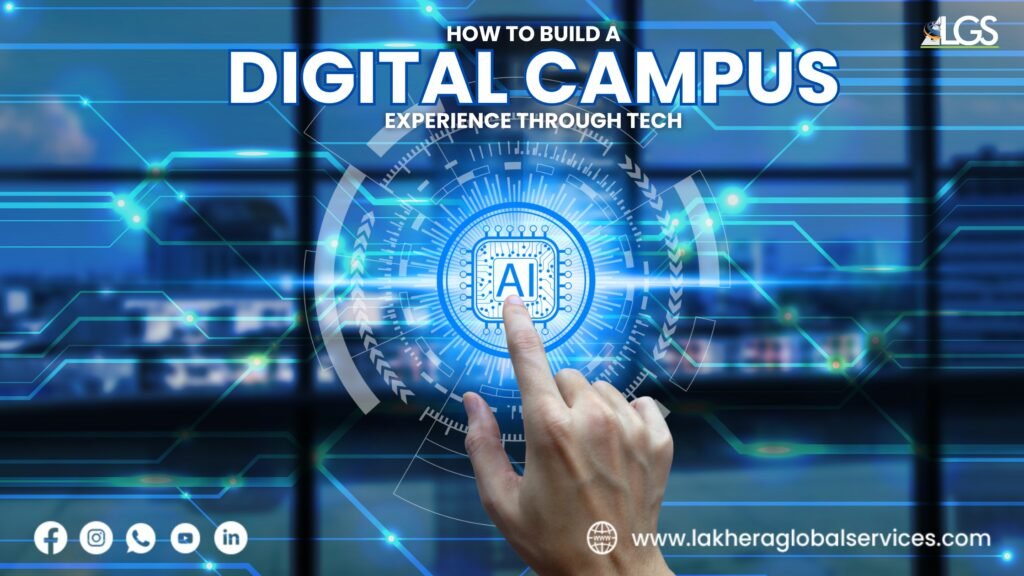In today’s tech-driven world, educational institutions must evolve beyond traditional learning models. If you want to attract digitally savvy students, it’s time to build a digital campus experience through tech. From admissions and classrooms to student engagement and alumni networking—technology is now central to every phase of a student’s academic journey.
Whether you’re a college director or administrator in Mohali, Chandigarh, or any Tier-2 city in India, building a seamless and connected digital campus experience can greatly enhance student satisfaction, learning outcomes, and brand perception.
Key Takeaways
- A digital campus enhances efficiency, convenience, and engagement for students and staff.
- Tech enables a personalized learning experience across devices and platforms.
- Online systems reduce manual tasks and streamline communication.
- Analytics from digital tools improve decision-making and course development.
- A strong digital campus improves brand positioning and student enrollments.
Why Digital Transformation is No Longer Optional
With the global shift toward hybrid learning and the rise of Gen Z and Gen Alpha learners, the expectations from educational institutions have transformed. These digital natives expect:
- Instant access to information
- Seamless digital experiences
- Personalized learning journeys
- Social interaction in digital spaces
A 2024 survey by Deloitte found that 82% of students in Tier-2 cities prefer institutions offering hybrid education models with strong tech infrastructure. Institutions that fail to meet this demand risk falling behind.
1. Establish a Centralized Digital Infrastructure
Why It’s Crucial:
To build a digital campus experience through tech, institutions need a central ecosystem where every stakeholder—students, faculty, and administrators—interacts through an integrated interface.
Must-Have Systems:
- Learning Management Systems (LMS) like Moodle or Canvas
- Student Information Systems (SIS) for managing enrollment, grades, and attendance
- ERP Software for finance, HR, and academic operations
- Cloud Storage (e.g., Google Drive, OneDrive) for document collaboration
Real Example:
A Tier-2 college in Himachal Pradesh implemented Google Workspace and automated over 70% of their manual academic operations, leading to a 40% improvement in faculty efficiency.
2. Offer Hybrid and Remote Learning Options
Modern Learning Preferences:
Hybrid models combine online convenience with offline interaction. This flexibility allows students to learn at their own pace and attend classes from remote locations.
Recommended Tools:
- Zoom, Google Meet, or Microsoft Teams for virtual lectures
- Kahoot! or Quizizz for gamified quizzes
- Discussion boards for community interaction
- Pre-recorded video libraries
Pro Tip:
Encourage teachers to record sessions and host them on the LMS so students can revisit content anytime.
3. Digitalize the Admissions and Enrollment Process
First Impressions Matter:
The admission journey should be simple and digital. An efficient online process makes your institution appear tech-savvy and student-centric.
Essential Components:
- Online registration and application forms
- Document upload and verification modules
- Secure payment gateways
- AI chatbots for 24×7 FAQs
Case Study:
A Chandigarh-based college moved its admissions online and saw a 40% increase in applications, mainly due to ease of access for outstation students.
4. Enhance Campus Life with Mobile Apps
Why Mobile Matters:
Students spend an average of 4–6 hours on mobile devices daily. A dedicated campus app ensures you stay connected with them where they already are.
Must-Have Features:
- Class schedules and assignment trackers
- Attendance records and grade reports
- Notifications and campus news
- Feedback and query submission modules
Bonus:
Push notifications improve communication and reduce delays in student actions.
5. Use Data Analytics for Smarter Decision-Making
Data = Power:
Your digital systems generate insights that can shape policy, curriculum design, and even student mental health interventions.
Metrics to Track:
| Metric | Why It Matters | Tool Recommendation |
| Attendance Trends | Identify engagement issues | LMS or ERP dashboards |
| Course Completion Rates | Understand academic performance | Power BI, Tableau |
| Lead Conversion Data | Evaluate admission campaign success | Google Analytics, CRM |
| Faculty Performance Reviews | Quality assurance and training | Student surveys, LMS logs |
6. Leverage VR and AR for Immersive Learning
Going Beyond Textbooks:
Virtual Reality (VR) and Augmented Reality (AR) can turn theoretical learning into immersive experiences.
Ideas for Implementation:
- Virtual campus tours for remote applicants
- AR-enhanced biology or chemistry labs
- VR simulations in fields like medicine and engineering
Impact Stat:
Studies show that VR-enhanced education improves student retention by up to 70% compared to traditional methods.
7. Foster Online Communities and Networking
Why It’s Important:
Learning isn’t just about classes—it’s also about peer interaction. Online communities build emotional connection and belonging.
Tools to Use:
- WhatsApp, Discord, or Slack groups for informal student discussions
- Alumni forums and mentorship platforms
- Virtual event platforms for competitions and webinars
8. Improve Accessibility and Inclusivity Through Tech
Making Education Universal:
Digital tools can make education more inclusive for students with diverse needs, languages, and locations.
Inclusion Techniques:
- Screen readers and accessible fonts for visually impaired learners
- Language translation tools for regional students
- Subtitles and transcription in all video content
9. Ensure Data Privacy and Cybersecurity
Protecting Stakeholder Trust:
As campuses become digital, so do the risks. Students and faculty trust you with sensitive data—protecting it is paramount.
Security Practices:
- Use SSL encryption on all portals
- Regular software updates and audits
- Role-based access to confidential data
- Train staff and students in cyber hygiene
Tracking the Digital Shift: Metrics Table
| Component | Metric to Monitor | Target Goal |
| Student Mobile App | Daily Active Users (DAU) | 60–70% DAU among students |
| LMS Engagement | Course completion rate | 85%+ completion |
| Admissions Portal | Conversion rate | 10–15% increase YoY |
| Website & SEO Traffic | Monthly visitor growth | 25–30% growth |
| Feedback System | Response rate | 70%+ from students |
Conclusion: Go Digital, Stay Ahead
To build a digital campus experience through tech, institutions must think strategically, act progressively, and implement consistently. This transformation is not a luxury—it’s a necessity for institutions aiming to stay relevant in a fast-evolving educational world.
Whether it’s digitizing admissions or integrating immersive VR labs, every step you take toward becoming a digital-first campus enhances your ability to serve students better and scale operations faster.
Partner With Lakhera Global Services Pvt Ltd
We specialize in helping educational institutions like yours leverage digital marketing and tech solutions to grow their brand, improve student enrollment, and offer cutting-edge learning experiences.
FAQs: Building a Digital Campus Through Tech
1. What is a digital campus?
A digital campus uses technology to manage academics, administration, and student life through online platforms, apps, and data systems.
2. How long does it take to implement a digital infrastructure?
Depending on the scale, it can take 3–6 months for full implementation and training.
3. Is it suitable for smaller colleges or rural institutions?
Yes, especially with mobile-first solutions and modular LMS platforms that scale easily.
4. What are the most cost-effective tools to start with?
Start with a basic LMS, mobile app, and digital admissions system. Many tools have affordable or freemium models.
5. How can Lakhera Global Services assist in digital campus transformation?
We offer tailored solutions like ERP setup, LMS integration, mobile app development, content creation, and branding strategies for educational institutions.









